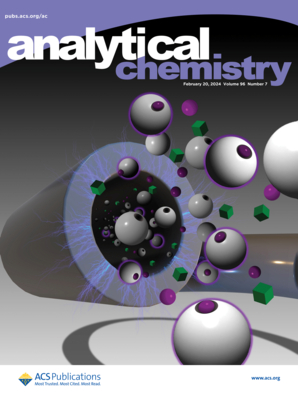Determination of Methyl Group Positions in Long-Chain Aliphatic Methyl Ethers and Alcohols by Gas Chromatography/Orbitrap Mass Spectrometry.
IF 6.7
1区 化学
Q1 CHEMISTRY, ANALYTICAL
引用次数: 0
Abstract
Methylated long-chain aliphatic compounds such as terminal methyl ethers are a common compound type found on the epicuticular layer of arthropods, e.g., spiders. Because complex mixtures are encountered in small amounts when analyzing these mixtures, GC/MS is the method of choice for characterizing the individual constituents. However, the methyl branch location cannot be deduced from the original spectra due to the easy loss of methanol, resulting in nonspecific spectra, and a complex derivatization scheme has been employed to address this issue. We noted that although mass spectra obtained by EI-quadrupol and EI-Orbitrap ionization are superficially quite similar, a +2.0 V C-trap offset of the latter leads to reduced fragmentation. The high-resolution Orbitrap spectra contain enough information to allow for methyl group localization in the chain. However, the spectra of the methyl ethers contain many ions, making individual analysis quite time-consuming. Therefore, scripts using Excel and R were developed with the help of ChatGPT 4.0, resulting in ion series spectra (ISS) that contained only ions of a specific ion series. The analysis of 11 synthetic methyl ethers showed that especially the ion series CnH2n+1O (ISS45) and CnH2n-2 (ISS40) are of high diagnostic value, together with some methoxy group-induced fragmentation. The approach was successfully tested with lipids from the spider Tetragnatha versicolor, which had been previously analyzed by derivatization, and with web extracts of Erigone atra, revealing 1-methoxy-2,16-dimethylhenicosane as a male-specific component─the first spider methyl ether in a volatility range that would allow detection via the gas phase. This approach can also be applied to structurally related primary alcohols, although the diagnostic ions are of lower intensity.气相色谱/轨道阱质谱法测定长链脂肪族甲基醚和醇的甲基位置。
甲基化的长链脂肪族化合物,如末端甲基醚,是节肢动物(如蜘蛛)表皮层上常见的化合物类型。由于在分析这些混合物时会遇到少量的复杂混合物,因此GC/MS是表征单个成分的首选方法。然而,由于甲醇容易损失,无法从原始光谱中推断出甲基分支的位置,导致非特异性光谱,因此采用复杂衍生化方案来解决这一问题。我们注意到,虽然ei -四pol和EI-Orbitrap电离获得的质谱表面上非常相似,但后者的+2.0 V C-trap偏移导致碎片减少。高分辨率的Orbitrap光谱包含足够的信息来确定甲基在链中的定位。然而,甲基醚的光谱包含许多离子,使得单独的分析相当耗时。因此,在ChatGPT 4.0的帮助下,利用Excel和R开发了脚本,得到了只包含特定离子系列离子的离子系列光谱(ISS)。对11种合成甲基醚的分析表明,特别是CnH2n+ 10 (ISS45)和CnH2n-2 (ISS40)离子系具有较高的诊断价值,并伴有一些甲氧基诱导的断裂。该方法成功地用先前通过衍生化分析过的Tetragnatha versicolor蜘蛛的脂质和Erigone atra的网状提取物进行了测试,结果显示1-甲氧基-2,16-二甲苯基醚是雄性特有的成分──这是第一个挥发性范围内的蜘蛛甲醚,可以通过气相检测。这种方法也可以应用于结构相关的伯醇,尽管诊断离子的强度较低。
本文章由计算机程序翻译,如有差异,请以英文原文为准。
求助全文
约1分钟内获得全文
求助全文
来源期刊

Analytical Chemistry
化学-分析化学
CiteScore
12.10
自引率
12.20%
发文量
1949
审稿时长
1.4 months
期刊介绍:
Analytical Chemistry, a peer-reviewed research journal, focuses on disseminating new and original knowledge across all branches of analytical chemistry. Fundamental articles may explore general principles of chemical measurement science and need not directly address existing or potential analytical methodology. They can be entirely theoretical or report experimental results. Contributions may cover various phases of analytical operations, including sampling, bioanalysis, electrochemistry, mass spectrometry, microscale and nanoscale systems, environmental analysis, separations, spectroscopy, chemical reactions and selectivity, instrumentation, imaging, surface analysis, and data processing. Papers discussing known analytical methods should present a significant, original application of the method, a notable improvement, or results on an important analyte.
 求助内容:
求助内容: 应助结果提醒方式:
应助结果提醒方式:


